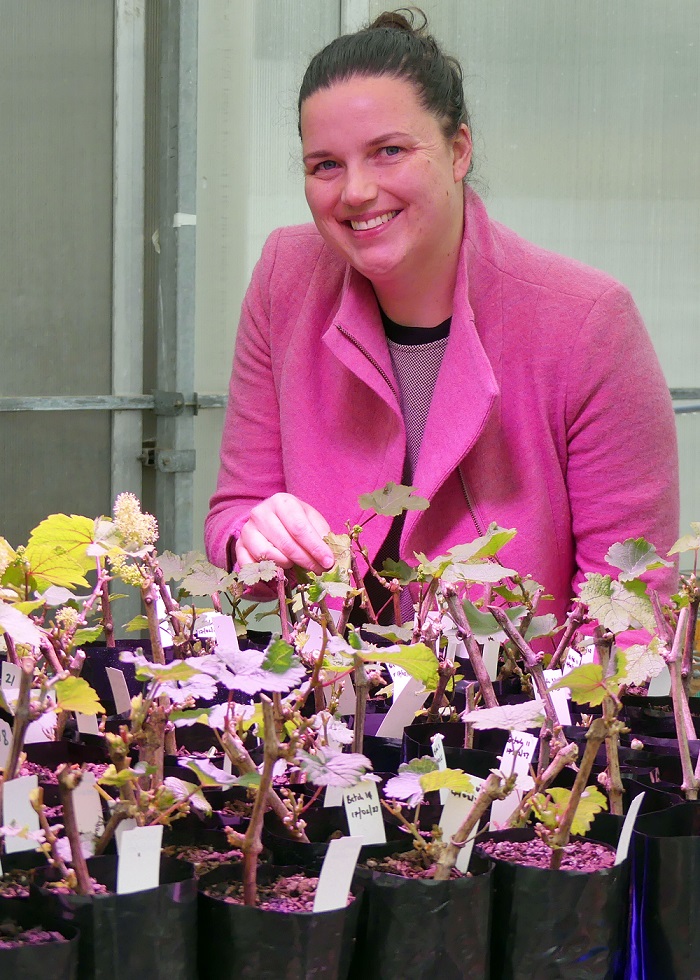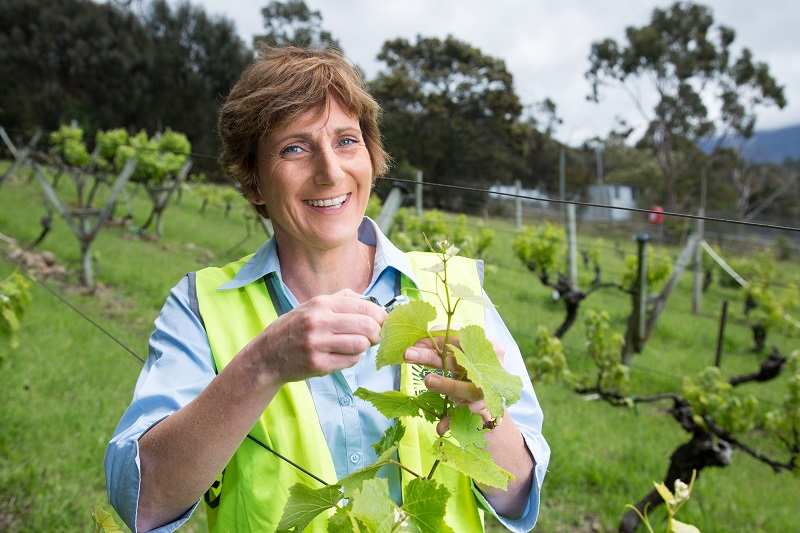Researchers at the Tasmanian Institute of Agriculture (TIA) are leading a world-first project to investigate the use of BioClayTM to supress botrytis bunch rot disease in wine grapes.
It could be a game-changer for the wine industry, offering growers an innovative alternative to chemical fungicides. Working on the project are Professor Kathy Evans, Dr Tory Clarke, and PhD student Akeem Taiwo. The project is part of the Australian Research Council (ARC) Research Hub for Sustainable Crop Protection.
“This is the first time in the world that the BioClay technology is being tested for suppression of botrytis in wine grapes. The goal of our project is to investigate how the technology can work in this crop, and this will support the long-term development of a potential product for use here in Tasmania and around the world,” Dr Clarke said.
It is estimated that the processed value of wine grapes in Tasmania could be 24 per cent higher if costs due to botrytis disease are recuperated.
BioClay is a completely new crop protection approach that was developed from research led by Professor Neena Mitter and Professor Gordon Xu at the University of Queensland. It is a biodegradable spray solution of clay particles that binds double-stranded (ds) RNA and releases it slowly, working with the plant’s naturally occurring mechanisms to stimulate the immune system to fight disease.
“At the moment we are working without the clay component to confirm that the RNA science works in grapevines. We are treating grape berries with the dsRNA product and then inoculating the berries with the botrytis fungus to establish how much we can reduce the incidence of disease with this treatment,” Dr Clarke said.
Dr Clarke said botrytis bunch rot is a major challenge for wine grape growers as it results in significant loss of yield and can create costly problems during winemaking, despite management practices being applied during the season.
“Botrytis can be triggered by weather events like rainfall in the weeks leading to harvest. Mould can appear really quickly, and you can go from having perfect grapes to losing your crop in a matter of days,” Dr Clarke said.
While the disease is seen in ripening fruit, infection may have occurred in grape flowers or unripe fruit. With this in mind, an important part of the project includes setting-up a novel system to give the research team access to flowering grapevines all year round.
“One of the challenges we have in wine grapes is that it is a woody perennial plant which flowers just once a year. We know that flowering is a critical point in the disease development and so what we’ve done over the last year is set up a system where we can have access to flowering grapevines all the time,” Dr Clarke said.
“We propagate commercial cuttings of vines, get their roots growing and then put them in the glasshouse where we control temperature and light to replicate flowering conditions.
“Our little grapevines think it’s spring and so they start flowering. It takes around four months from cuttings to having vines with berries, but we now have regular batches of plants coming through our propagation system which flower and produce grape berries.”
After all the hard work setting up a mini vineyard, the research team now need to inoculate the plants with botrytis so they can further test and develop the BioClay product.
“We will inoculate plants by puffing spores onto the flowers or fruit to replicate what would happen in the environment where spores would be in the air,” Dr Clarke said.
“We will test the BioClay effectiveness against botrytis bunch rot disease in glasshouse trials to develop an understanding of how to best use the product, including application, concentration, timing, and its effectiveness compared to other controls and chemical treatments currently used in vineyards.
“It will be interesting to see the results because coupling dsRNA to a clay stabilises it and results in a sustained release, so we can get longer protection for the crop compared to current chemical solutions that might be washed away by rain.”
The final part of this project will involve working with growers and testing the technology in commercial vineyards, which may be several years away and will depend on key results being achieved.
Professor Evans said producers are desperate for more options to control botrytis in vineyards.
“Good viticultural practices can counter some of the bad weather; however, a well-timed crop protectant can make the difference between a winemaker accepting or rejecting crop for a particular wine style. The big hope is that BioClay will prove to be a valuable addition to the toolbox,” Professor Evans said.
The project is part of the ARC Research Hub for Sustainable Crop Protection and funded by the Australian Government. The Australian Wine Research Institute and the South Australian Research and Development Institute are also contributing to the wine-grape research led from Tasmania.
What is BioClayTM?
- BioClay™ is a completely new crop protection approach that is safe for people and the environment.
- It is a biodegradable spray solution of clay particles that bind dsRNA, releasing it slowly to fight pests for longer.
- dsRNA is a well understood, highly specific and targeted way to help plants protect themselves, working with the plant’s natural mechanisms, stimulating the immune system to fight disease. The clay particles on the leaf surface degrade in the presence of natural carbon dioxide and moisture, leaving no residue or toxins.
- BioClay™ is being developed by University of Queensland and Nufarm Limited for farmers globally.
Want to know more about TIA's research for Tasmania's agriculture and food sectors? Subscribe to TIA's newsletter to keep in touch.




